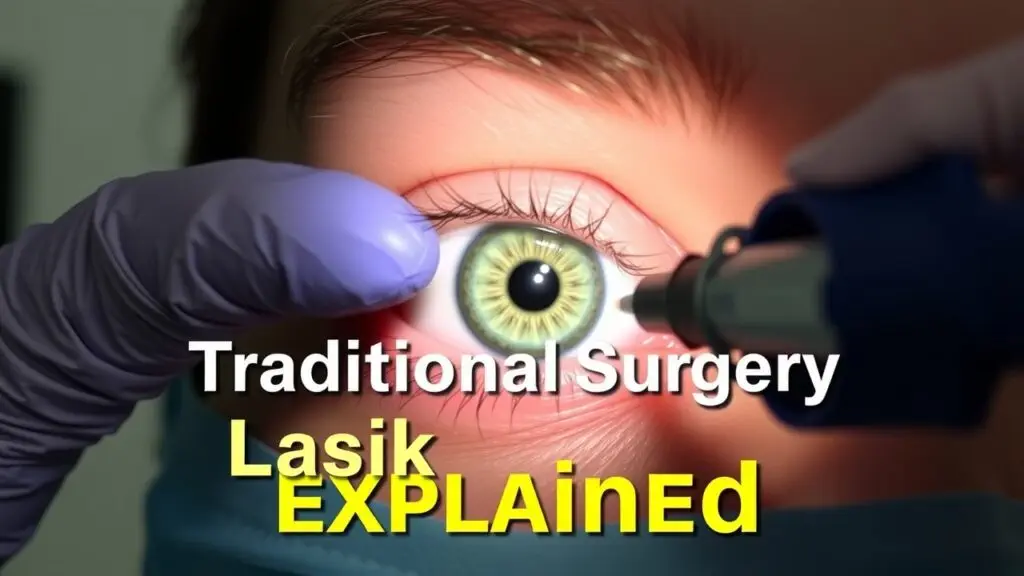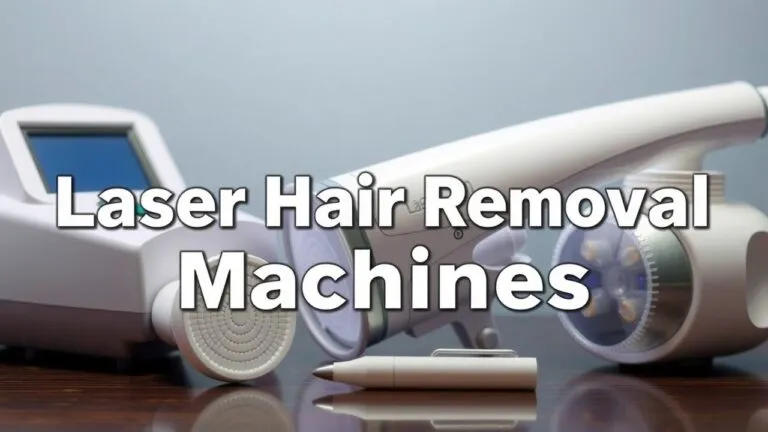This guide explains the different types of LASIK, including custom LASIK and iFS, comparing their benefits to help you choose the best option for your needs.
What is LASIK?

Laser-assisted in situ keratomileusis, or LASIK, is a popular eye surgery that fixes vision issues like nearsightedness, farsightedness, and astigmatism. This type of corrective eye surgery reshapes the cornea. When light enters the eye, it gets focused better on the retina. This improvement helps people see more clearly.
Many different types of LASIK procedures exist today. Each one aims to meet the unique needs of patients. Knowing about these options helps people make better decisions for their vision correction.
How does LASIK work?
LASIK has two main steps: making a corneal flap and reshaping the cornea with an excimer laser. First, a thin flap is created on the surface of the cornea. This can be done using a blade or a laser in bladeless procedures. After lifting the flap, an excimer laser removes tiny bits of tissue from beneath it.
This changes how the cornea curves, allowing light rays to enter and focus properly in the eye. The goal is to lessen or even get rid of the need for glasses or contacts. It works by fixing both higher-order aberrations, which are complex vision issues, and lower-order aberrations like nearsightedness or farsightedness.
Why are there different types of LASIK procedures?
There are various types of LASIK procedures due to advancements in technology that allow for customized treatment plans based on individual visual needs. Some key options include:
- Wavefront-guided LASIK: This method uses special measurements from wavefront technology that shows how light moves through your eyes. It helps fix complex vision problems more effectively than older methods.
- Topography-guided LASIK: Here, detailed maps of your cornea’s shape guide the surgery, making adjustments that suit your specific irregularities.
Bladeless or all-laser LASIK adds precision by using lasers instead of blades for flap creation. This often results in quicker recovery times and less discomfort afterward.
Understanding these various types enables potential candidates to find an option that suits their specific vision challenges and lifestyle preferences while receiving quality care throughout their path toward clearer sight.
Traditional LASIK Explained
What is traditional LASIK surgery?
Traditional LASIK, known as laser-assisted in situ keratomileusis, is a popular vision correction method. It uses an excimer laser to reshape the cornea. First, a corneal flap is created. This can be done with a microkeratome or a femtosecond laser. Once the flap is lifted, the excimer laser removes tissue beneath it to correct vision problems like myopia (nearsightedness), hyperopia (farsightedness), and astigmatism. After reshaping, the flap is placed back over the treated area, promoting quick healing and improved sight.
Step-by-step process of traditional LASIK
The operative procedure for traditional LASIK includes several important steps:
- Pre-operative evaluation and consultation: Patients have thorough eye exams to check if they are suitable for surgery.
- Anesthesia administration: Topical anesthetic drops are used to ensure comfort during the surgery.
- Corneal flap creation: A microkeratome or femtosecond laser makes a thin flap on the cornea’s surface.
- Excimer laser application: The excimer laser reshapes the corneal tissue based on precise measurements taken before the procedure.
- Flap repositioning: After reshaping, the corneal flap is carefully put back in place.
This step-by-step method allows for accurate correction of vision issues while reducing discomfort.
Who can benefit from traditional LASIK?
Ideal candidates for traditional LASIK typically meet specific criteria regarding their eye health:
- Age requirement: Candidates should generally be at least 18 years old.
- Stable vision prescription: A consistent prescription for at least one year suggests stable eyesight.
- Absence of eye diseases: Conditions like cataracts or glaucoma may prevent someone from having this surgery.
- Sufficient corneal thickness: Adequate thickness ensures safe flap creation and effective results.
These factors help determine if someone will achieve good results from this type of vision correction surgery.
Advantages and disadvantages of traditional blade-based techniques
Traditional blade-based techniques have both advantages and disadvantages that patients should weigh carefully:
Advantages:
- Established technology with a long history of success; many studies back its effectiveness in improving vision across various refractive errors.
Disadvantages:
- Potential complications related to flap creation may occur, such as issues with positioning or healing after surgery.
Understanding these pros and cons helps individuals considering different types of LASIK procedures make informed choices based on their needs and circumstances.
Wavefront-Guided and Topography-Guided Customizations in Laser Eye Surgery
Wavefront-Guided vs. Wavefront Optimized – Key Differences Explained
Wavefront-guided LASIK and wavefront-optimized LASIK are two modern methods used to improve laser vision correction. The main difference between them is how they handle visual issues, especially higher-order aberrations, which can affect the quality of your vision.
Wavefront-guided LASIK uses detailed maps created by an aberrometer. This device identifies specific optical errors in the eye, capturing both lower-order and higher-order aberrations. These higher-order issues can cause problems like glare or halos around lights, especially at night. By customizing the treatment based on this data, wavefront-guided LASIK aims to enhance clarity and contrast sensitivity for better overall vision.
On the other hand, wavefront-optimized LASIK mainly focuses on correcting lower-order aberrations while keeping the cornea’s natural shape. This helps to reduce possible side effects from the surgery. Although it provides significant improvements over traditional methods, it does not customize treatment for higher-order aberrations as effectively as wavefront-guided LASIK.
| Feature | Wavefront-Guided LASIK | Wavefront-Optimized LASIK |
|---|---|---|
| Aberration Correction | Higher-order & lower-order | Primarily lower-order |
| Technology Used | Aberrometer | Standard wavefront analysis |
| Customization Level | High | Moderate |
| Visual Quality Improvement | Enhanced | Good |
How wavefront technology works for personalized corrections?
WaveScan technology plays a key role in personalizing corrections with custom LASIK procedures. This advanced system creates a precise map of your eye’s surface through corneal mapping techniques. An aberrometer measures how light travels through your eyes to identify distortions.
With this information, ophthalmologists can customize treatments to match each patient’s unique vision profile. Options like CustomVue LASIK allow patients to receive tailored care that effectively addresses their specific refractive errors.
Addressing higher-order aberrations with wavefront-guided methods
Higher-order aberrations lead to complex visual disturbances beyond standard refractive errors. They can impact visual acuity and overall sight quality after surgery. Many traditional methods do not address these issues well, leaving some patients unsatisfied with their results.
By using wavefront-guided techniques in refractive surgery, surgeons can target these irregularities directly. They use laser adjustments based on individual measurements taken before the procedure. As a result, many patients report improved night vision and reduced glare after their surgery.
Topographic mapping custom correction profile vision technology
Topography-guided LASIK offers an innovative approach within laser eye surgery to improve outcomes using customized profiles from corneal topography assessments. This technique examines slight variations across the cornea’s surface, giving surgeons insights into how best to reshape it during treatment.
Similar ideas apply when considering customized PRK (Photorefractive Keratectomy). Here too, topographic information helps refine surgical strategies tailored specifically for each patient’s unique anatomy.
Both techniques offer benefits depending on individual needs. Understanding these options can empower people seeking effective solutions among different types of LASIK available today, helping them make informed choices about their eye health.
All-Laser (Bladeless) LASIK
What is bladeless LASIK?
Bladeless LASIK, often called all-laser LASIK, is a modern technique for vision correction. It uses laser technology instead of a surgical blade. This method employs a femtosecond laser to create a precise flap in the cornea. This is safer and more accurate than older techniques. The IntraLase Method and iFS LASIK are popular examples of this approach. By avoiding the blade, bladeless LASIK reduces risks of flap issues and helps patients heal faster.
Step-by-step process of all-laser LASIK
The process of all-laser LASIK can be broken down into these key steps:
- Preoperative Evaluation: The doctor checks your eyes to understand your vision needs.
- Anesthesia Administration: Numbing drops make sure you feel no pain during the procedure.
- Corneal Flap Creation: A femtosecond laser creates a thin flap on your cornea.
- Excimer Laser Treatment: Once the flap is lifted, an excimer laser reshapes the cornea to correct your vision.
- Flap Repositioning: The surgeon carefully puts the flap back without needing stitches.
- Postoperative Care: You’ll get instructions on how to take care of your eyes after surgery.
This clear step-by-step process shows how advanced technology makes laser eye surgery safer and more effective.
Who is a good candidate for bladeless LASIK?
Not everyone is a fit for bladeless LASIK, but ideal candidates typically include people who:
- Are 18 years old or older
- Have had stable vision for at least one year
- Have enough corneal thickness; thin corneas might not work for this procedure
- Don’t have major eye diseases that could complicate healing
Those looking to fix common vision problems like nearsightedness, farsightedness, or astigmatism often qualify for this type of surgery.
Advantages and disadvantages of bladeless LASIK
It’s important to know both the advantages and disadvantages before deciding on bladeless LASIK.
Advantages of Bladeless LASIK:
- Enhanced Precision: Lasers create flaps more accurately than traditional blades.
- Reduced Risk of Complications: Fewer flap-related problems lead to higher patient satisfaction.
- Quicker Recovery Time: Many patients notice better vision soon after because there’s less damage to nearby tissues.
Disadvantages of Bladeless LASIK:
- Higher Cost: It tends to be pricier than traditional methods due to advanced tech.
- Not Suitable for Everyone: Certain issues like dry eyes or extreme prescriptions may disqualify some people.
Understanding these pros and cons can help you decide if this innovative approach fits your needs when considering various types of LASIK procedures today.
SMILE (Small Incision Lenticule Extraction)
What is SMILE?
SMILE stands for Small Incision Lenticule Extraction. It’s a modern laser eye surgery used for vision correction. This procedure belongs to the category of refractive surgery and mainly treats myopia, or nearsightedness, along with astigmatism. Unlike traditional LASIK, which creates a corneal flap, SMILE uses a smaller incision in the cornea. This approach allows doctors to remove tiny pieces of tissue, called lenticules, from inside the cornea. By reshaping the cornea this way, patients can see more clearly.
Step-by-step process of SMILE
The process of SMILE involves several important steps:
- Preoperative Procedures: Patients first go through thorough eye exams to see if they are suitable for the surgery.
- Laser Application: A special femtosecond laser creates a thin lenticule within the cornea without cutting through its surface layers.
- Incision Creation: The surgeon makes a small incision (about 2-4 mm) on the surface of the cornea.
- Lenticule Removal: Using special tools, the surgeon removes the lenticule through this small incision.
- Healing Process: After removing the lenticule, there’s no need for stitches since the body heals quickly due to minimal damage to surrounding tissues.
This straightforward process leads to faster recovery times compared to other LASIK methods while ensuring high precision in correcting vision.
Who is a good candidate for SMILE?
Good candidates for SMILE usually have:
- Myopia or Mild Astigmatism: People looking to correct these issues often benefit most from this surgery.
- Thin Corneas: Those with adequate corneal thickness can undergo this procedure safely.
- Stable Vision Prescription: Candidates should have had stable prescriptions for at least a year before surgery.
- Age Considerations: Typically, individuals aged 18 and older whose eyes have fully developed qualify.
This option may be appealing to patients who are wary of traditional LASIK due to flap creation concerns.
Advantages and disadvantages of SMILE
Here are some advantages of SMILE:
- Minimally Invasive Nature: Since it requires just a small incision, there’s less risk of complications common with flap surgeries.
- Faster Recovery Time: Many people notice quicker improvements in their vision than with standard LASIK.
- Reduced Dry Eye Symptoms: Research shows fewer cases of dry eye after this procedure because it disrupts fewer nerves during surgery.
However, there are also some disadvantages:
- Limited Treatment Range: Currently, SMILE is mainly effective for myopia and astigmatism; those needing hyperopia treatment may need other options like PRK or traditional LASIK.
- Learning Curve for Surgeons: Because it’s an advanced technique requiring specific training, finding experienced surgeons might be tough in some areas.
Despite these downsides, many patients report high satisfaction levels after choosing this innovative option among available LASIK types today.
Comparing LASIK Types: A Quick Reference Guide

Key Comparison Factors
When looking at different laser vision correction options, several factors stand out. These include flap creation, precision in correcting vision, cost of each procedure, recovery time needed, and how suitable each option is for various eye conditions.
Flap creation is a key part that sets traditional methods apart from newer techniques. Traditional and wavefront-guided procedures create a corneal flap using either a blade or laser. On the other hand, all-laser options like bladeless LASIK and SMILE skip this step entirely.
Precision is another important factor. Wavefront-guided technologies use advanced mapping tools to enhance accuracy in treating complex vision problems. Costs can vary widely; while traditional methods are usually more affordable upfront, advanced techniques may offer longer-term benefits that justify their higher prices.
Recovery times differ as well—most patients see improved vision within a day after all-laser surgeries. However, others might take longer based on individual healing rates.
Each Procedure’s Features
Traditional LASIK involves creating a thin flap in the cornea using either a microkeratome or femtosecond laser. The reshaping of the cornea with an excimer laser helps address common refractive errors like myopia (nearsightedness), hyperopia (farsightedness), and astigmatism. Some discomfort may occur post-surgery due to the presence of the flap.
Wavefront-guided LASIK takes this further by using custom mapping technologies. These technologies analyze how light travels through the eye, allowing for tailored corrections that target unique imperfections beyond standard prescriptions. This method is great for people dealing with complex visual challenges.
All-laser or bladeless LASIK uses lasers for both flap creation and tissue shaping processes. This method generally leads to less discomfort during recovery and delivers very precise results suitable for various refractive issues.
SMILE is another innovative option where only small incisions are made without creating a full corneal flap. It mainly addresses myopia and mild astigmatism while reducing disruption to surrounding tissues. Many patients appreciate its quick recovery time.
Choosing the right type of laser surgery depends on individual needs influenced by lifestyle and specific eye conditions assessed during initial consultations. Factors such as your daily activities and any pre-existing conditions should guide your decision-making process. Working closely with your healthcare provider ensures you find an option that fits you best!
Choosing the Right LASIK Procedure for You
When you’re thinking about LASIK surgery, it’s key to look at several factors that can affect how well the procedure works for you. You should think about the severity and type of refractive error, corneal thickness, overall eye health, lifestyle choices, costs involved, and what your doctor recommends.
Factors to Consider
- Severity and Type of Refractive Error: Different types of LASIK target specific vision problems like myopia (nearsightedness), hyperopia (farsightedness), and astigmatism. Knowing your exact refractive error helps in choosing the right procedure.
- Corneal Thickness: The thickness of your cornea is crucial. Certain LASIK techniques, such as bladeless or wavefront-guided LASIK, usually need a thicker cornea to be safe.
- Eye Health Assessment: Before any kind of refractive surgery, getting a full eye checkup from an ophthalmologist is very important. Issues like dry eye syndrome or past eye injuries could impact both whether you can have the surgery and how you recover afterward.
- Lifestyle Preferences: Your everyday activities might influence which LASIK type is best for you. For example, if you have an active lifestyle, you may want a faster recovery option like all-laser LASIK compared to traditional methods.
- Cost Considerations: When looking into types of LASIK procedures, remember to consider both immediate costs and potential long-term savings on glasses or contacts.
- Doctor’s Recommendation: Speaking with a qualified ophthalmologist who knows your situation gives you tailored advice on which procedure fits your needs best.
Importance of a Comprehensive Eye Exam
Getting a thorough pre-operative evaluation during a LASIK consultation is crucial for good outcomes. This assessment usually involves detailed measurements like corneal mapping and pupil size under different light conditions—these details help customize the procedure to fit each patient’s eyes perfectly.
During this consultation, it’s important to share your medical history and discuss any worries about risks tied to different laser treatments.
Addressing Specific Concerns
Patients often worry about certain complications after surgery. Two common issues are dry eyes and thin corneas:
- Dry Eye Treatment After LASIK: After laser vision correction, many patients experience temporary dryness due to changes in tear production caused by the procedure itself.
- Thin Cornea Candidates for LASIK: If someone has thinner-than-average corneas, they might need to look into other options like PRK (Photorefractive Keratectomy) since standard LASIK could carry higher risks if there isn’t enough tissue support during reshaping processes.
Choosing the right type of LASIK requires careful thought across various areas including personal health factors alongside professional advice aimed at achieving clear vision while reducing risks associated with these advanced surgeries.
FAQs about LASIK Types
What are the different types of LASIK procedures?
LASIK includes several types like traditional LASIK, bladeless LASIK, wavefront-guided LASIK, and SMILE. Each method caters to unique vision needs.
How is blade LASIK different from bladeless LASIK?
Blade LASIK uses a microkeratome to create a corneal flap. Bladeless LASIK employs a femtosecond laser for flap creation, enhancing precision and safety.
What is CustomVue LASIK?
CustomVue LASIK personalizes vision correction using wavefront technology. It addresses both lower-order and higher-order aberrations for optimal outcomes.
What are the advantages of topography-guided LASIK?
Topography-guided LASIK uses detailed maps of the cornea. It customizes treatment based on individual corneal shapes, improving visual clarity.
How does SMILE differ from traditional LASIK?
SMILE requires only a small incision. Traditional LASIK creates a larger flap, which can lead to more discomfort and longer recovery.
Is PRK better than LASIK for certain patients?
PRK may be better for patients with thin corneas or those who prefer not to have a flap created. It reshapes the cornea without making a flap.
Advanced Vision Correction Techniques
- IntraLase (iFS) technology enhances flap creation in bladeless procedures.
- Wavefront-optimized PRK improves visual outcomes using advanced mapping.
- Topography-assisted LASIK offers personalized treatment based on corneal topography.
Considerations for Specific Conditions
- Monovision LASIK helps correct presbyopia by adjusting vision for near and distance tasks.
- Conductive keratoplasty (CK) provides an option for mild hyperopia correction.
- Refractive lens exchange (RLE) may suit patients not eligible for standard LASIK options.
Post-operative Care and Complications
- Dry eye treatment is essential after surgery to maintain comfort during recovery.
- Common side effects include glare, halos, and dry eyes post-LASIK surgery.
- Regular follow-ups help monitor healing and address potential complications early.
Future of LASIK Technology
- Advanced technologies like Technolas FEMTEC laser improve surgical precision.
- Ongoing research focuses on minimizing risks associated with refractive surgeries.
- Patient testimonials highlight the positive impact of new techniques on quality of life.
Related Topics
- Types of LASIK Procedures
- Types of Eye Surgery
- Types of Refractive Surgery
- Types of Vision Correction
- Types of Corneal Surgery
- Types of Laser Eye Surgery
- Types of Wavefront Technology in LASIK
- Types of LASIK Flap Creation Techniques
- Types of Post-LASIK Care
- Types of LASIK Candidates
- Types of LASIK Complications
- Types of Dry Eye Treatments after LASIK



Types of LASIK: A Complete Guide to Laser Eye Surgery Options